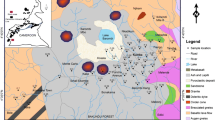Abstract
A total of 1094 water samples from 326 springs, 207 streams, 183 dug wells, 151 piped supplies, 90 tube wells, 75 hand pumps, 60 rivers and 2 lakes were collected from eight northern and six north-eastern districts of India. Samples were analysed to assess their potability by estimating the level of heavy metals and bacterial (coliform and faecal coliform) contaminations. Iron was found in a maximum number (53%) of water samples from hand pumps, followed by lead in 43% of the tube wells, chromium in 16% of dug wells, cadmium in 13% of streams and manganese in 7% of hand pumps above their maximum admissible concentrations (MACs). Maximum metal pollution has been observed in a considerable number of water samples from Doda, followed by Almora, Mirzapur and Bankura. Hand pump water samples exhibited maximum metal pollution followed by dug well, spring, stream and river water samples. Contamination of coliform and/or faecal coliform bacteria ranged between 41% and 67% of water samples from open water sources but it was also less, i.e. 6–15% of water samples from tube wells and hand pumps. In general, 42–85% of water samples from districts surveyed, except from Jammu (18%) and Mirzapur (27%), were found to be bacteriologically unsatisfactory. Since toxic metals and pathogenic bacteria pose a risk to public health, monitoring of drinking water sources is required.
Similar content being viewed by others
References
APHA: 1985, Standard Methods for the Examination of Water and Wastewater, 16th edition, American Public Health Association, Washington, D.C.
Babich, H. and Stotzky, G.: 1986, ‘Environmental Factors Affecting the Ability of Microbial Assays for the Toxicity and Mutagenicity of Chemical Pollutants’, in Dukta, B.J. and Bitton, G. (Eds.), Toxicity Testing Using Microorganisms, Vol. II, CRC Press Inc. Florida, pp. 9–42.
Bhattacherjee, J.W., Ramteke, P.W., Pathak, S.P. and Ray, P.K.: 1989, ‘Bacteriological Quanlity of Drinking Water in Rural India’, J. Ind. Water Works Assoc. April–June, 185–190.
Gautam, A.: 1992, ‘Conservation of Water Resources’, in Gautam, A. (Ed.), Aquatic Environment, Ashish Publishing House, New Delhi, pp. 100–105.
Harrison, R.M. and Laxen, D.P.H.: 1981, ‘Lead in Water,’ in Harrison, R.M. and Laxen D.P.H. (Eds.), Lead Pollution: Causes and Control, Chapman and Hall, N.Y., pp. 33–53.
Jana, S. and Bhattacharya, D.N.: 1988, ‘Effect of Heavy Metals on Growth Population of Faecal Coliform Bacterium Escherichia coli in Aquatic Environment’, Water Soil Pollut. 38, 251–254.
Kaphalia, B.S., Chandra, H., Bhargava, S.K., Seth, T.D. and Gupta, B.N.: 1981, ‘Lead in Drinking Water’, Ind. J. Env. Protect. 1, 92–96.
Kaul, V.: 1989, ‘Pollution of Water and Management Conservation of Aquatic Resources’, in Sinha, A.K., Ram Boojh and Viswanathan, P.N. (Eds.), Water Pollution (Conservation and Management), Gyanodaya Prakashan Nainital, India, pp. 65–69.
Nishio, T. and Ishida, Y.: 1990 ‘Production of Dihydroxamate Siderophore Alcaligin by Alcaligenese xylosoxidans subsp. xylosexidans’, Agric. Biol. Chem. 54, 1837–1839.
Paliwal, K.P.: 1983, ‘Pollution of Surface and Ground Water’, in Varshney, C.K. (Eds.). Water Pollution and Management, Wiley Eastern Ltd., New Delhi, pp. 36–60.
Pathak, S.P., Gaur, A. and Gopal, K.: 1992a ‘Bacterial Indicators of Pollution in Aquatic Environments’, in Gautam, A. (Ed.), Aquatic Environment, Ashish Publishing House, New Delhi, pp. 36–47.
Pathak, S.P., Kumar, S., Ramteke, Murthy, R.C., Singh, K.P., Bhattacherjee, J.W. and Ray, P.K.: 1992b, ‘Riverine Pollution in Some Northern and Northeastern States of India’, Environ. Monit. Assess. 22, 227–236.
Pillai, K.C.: 1983, ‘Heavy Metals in Aquatic Environment’, in Varshney, C.K. (Ed.), Water Pollution and Management, Wiley Eastern Ltd., New Delhi, pp. 75–93.
Vig, P.J.S., Singh, S., Singh, P., Prashar, S., Gulati, S., Paliwal, V.K. and Nath, R.: 1987, ‘Environmental Impact of Heavy Metals on Health’, in Kumar, R. (Ed.), Environmental Pollution and Health Hazards in India, Ashish Publishing House, New Delhi, pp. 138–146.
WHO: 1971, International Standards for Drinking Water, 3rd Edition, World Health Organization, Geneva.
WHO: 1985, Guidelines for Drinking Water Quality, Vol. 3, World Health Organization, Geneva.
Author information
Authors and Affiliations
Rights and permissions
About this article
Cite this article
Pathak, S.P., Kumar, S., Ramteke, P.W. et al. Potability of water sources in relation to metal and bacterial contamination in some northern and north-eastern districts of India. Environ Monit Assess 33, 151–160 (1994). https://doi.org/10.1007/BF00548595
Received:
Revised:
Issue Date:
DOI: https://doi.org/10.1007/BF00548595



